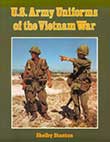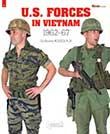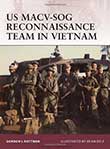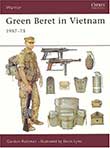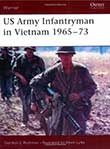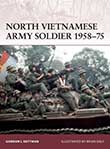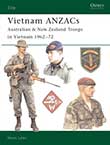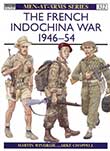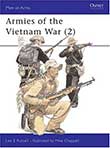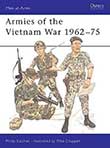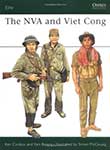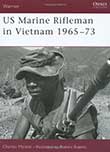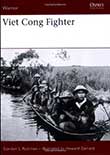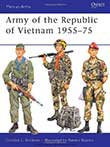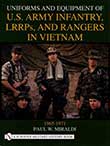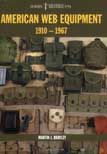

This is a great book—Stanton was a serving officer in Vietnam and when he did his research he had access to the working files at the Army's Natick Laboratory in Masachusetts to consult. He has used all the specifications and drawings that were published. In combination with his work on the Cold War which covers clothing worn elsewhere in the world this period is thoroughly covered.
Using only black & white photos and line drawings to illustrate the volume, the author still successfully describes the variety of Army uniforms of the Vietnam era. The safety/work clothing & related equipment are very loosely definable as a uniform clothing item of a combat, fatigue or service dress nature and could have been easily omitted. The listing of items by proper nomenclature was also very helpful. Some color would have been nice but there are other publications that complement this book. Bit sparse on field equipment but then this is a uniform study.
The book provides great details about equipment, uniforms and rations that were issued to the GI's during the war, and does a great job of bringing the modernity of the war to the forefront. The book shows a great number of the new and updated equipment the men carried, and does a great job of explaining the how, why, when and where.
This publication covers the chronological evolution of uniforms, equipment and weaponry issued to the American soldier during the first years of the conflict, from 1962 to 1967 (a second volume will cover the 1968 to 1975 period). All of the uniforms and equipment shown are period, however some of the weapons are replicas. In the aim of depicting characteristic servicemen at given periods, a great deal of research was undertaken in order to guarantee coherence between the units, dates and geographical situations. Differing from other publications, the author has deliberately chosen to illustrate all types of service personnel rather than solely combatants in order to give an exact presentation of the American military during this period. Indeed, it should be remembered that 85% of service personnel in Vietnam were support troops and advisors.
REVIEWS
Ideal for those interested in the detail of uniforms and history of the US involvement in Vietnam generally, but especially aimed at the militaria collectors and re-enactors who want to re-create specific uniforms for a specific time, place and unit. For the modeller, it is equally ideal thanks to modern colour photos showing real items of clothing and equipment from the period.... The quality of the photos is excellent, and the variety shown makes for a very handy uniform reference
Osprey's study of the Military Assistance Command of the Vietnam War (1955-1975). In 1964 Military Assistance Command, Vietnam, activated a joint unconventional task force known as the Studies and Observation Group--MACV-SOG. As a cover its mission was to conduct analysis of lessons learned in combat involved all branches of service. SOG's real mission was to conduct covert strategic reconnaissance missions into Laos, Cambodia, and South Vietnam as well as sabotage and 'Black' psychological operations. Ground, air, and naval assets were employed to insert, collect, extract, and otherwise support these operations. Drawing on detailed, first-hand accounts of the experiences of the service, including action on operations, this book will shed light on one of the most crucial units of the Vietnam War.
Vietnam was the US Special Forces' most complex and controversial mission, one that began in 1957 and ended in 1973. Camp strike forces, mobile strike forces, mobile guerrilla forces, special reconnaissance projects, training missions and headquarters duty provided vastly differing experiences and circumstances for SF soldiers. Other fluctuating factors were the terrain, the weather and the shifting course of the Vietnam War (1955-1975) itself. Gordon Rottman examines the training, life, weapons and combat experiences of the Special Forces soldier in this challenging environment.
This book tells the compelling story of the average US infantryman in the Vietnam War (1955-1975). Beginning with conscription, enlistment, Basic Training, and Advanced Individual Training at the Armed Forces Induction Center at Fort Polk (the infamous “Tigerland”), it goes on to explore the day-to-day realities of service in Vietnam, from routine tasks at the firebase to search-and-destroy missions, rocket attacks, and firefights in the field. Weaponry, clothing, and equipment are all described and shown in detailed color plates. A vivid picture of the unique culture and experiences of these soldiers emerges – from their vernacular to the prospect of returning to an indifferent, if not hostile, homeland.
The North Vietnamese Army is often forgotten by the histories of the Vietnam War (1955-1975). Commonly mistaken for the locally raised Viet Cong guerrillas, the NVA was in fact an entirely different force for the Democratic Republic of Vietnam. After first supporting the VC in the Republic of Vietnam in 1958, the NVA entered into their own violent armed struggle as the war escalated. Entire divisions and vast numbers of NVA troops were sent south, conducting large-scale operations in a conventional war fought almost entirely by the NVA, and not the VC, as is often believed. Despite limited armor, artillery and air support, the NVA were an extremely politicized and professional force with strict control measures and leadership concepts - soldiers were expected to be totally committed to the cause, and to sacrifice all to ensure its success. Gordon Rottman follows the fascinating life of the highly motivated infantryman from conscription and induction through training to real combat experiences. Covering the evolution of the forces from 1958 onwards, this book takes an in-depth look at the civilian and military lives of the soldiers, while accompanying artwork details the uniforms, weapons and equipment used by the NVA in their clash against America and her allies.
The part played by Australian and New Zealand troops in the Vietnam War (1955-1975) is sometimes overlooked; but it is generally accepted that the 'Diggers' and 'Kiwis' were among the most effective and professional troops involved. Drawing upon the ANZACs' long experience in the jungles of South East Asia, the men of the Task Force used their expertise in patrol tactics to great effect to frustrate Viet Cong operations. Meanwhile the ANZACs’ small and isolated adviser teams spent ten years passing on their skills all over South Vietnam, and in the process four were awarded the supreme decoration for valour - the Victoria Cross. This book pays tribute to their military prowess, and describes and illustrates their uniforms and equipment in unprecedented detail.
The states of Indochina had been French colonies or protectorates since the 19th century. However, in March 1945 the Japanese interned all French troops and officials, and turned over all civil government to local authorities. The power vacuum caused by the Japanese surrender allowed the Viet Minh, a strong revolutionary organisation, to be established throughout Vietnam. When the French returned to the north, incidents between French and VM troops were inevitable, negotiations collapsed and the French opted for a military solution. This book examines the history of the conflict and the forces of both sides of the French Indochina War (1946-1954).
On March 8th, 1965, some 3,500 US Marines, the first US combat troops to arrive in Vietnam, landed in Da Nang to defend the US air base there. On June 8th, following further reinforcements, General Westmoreland authorized his troops to begin "offensive patrolling." Lee Russell's follow-up to Men-at-Arms 104 focuses in finer detail on the uniforms and insignia of the US Army and Marines, the ARVN and the NVA. The book is packed with superbly detailed black and white photographs of the forces active in the Vietnam War, and Mike Chappell's excellent illustrations provide key reference material for the contemporary uniforms and battledress.
Philip Katcher provides an overview to the conflict that engulfed Vietnam following the division of the country into two along the 17th Parallel in 1954. The uniforms and insignia of the US forces, including the army, Special Forces, air force, navy and marine corps, are dealt with in detail, together with those of the ARVN, the Allied Forces (such as the Royal Thai Army and Korean troops), and also the Communist NLF (Viet Cong) and NVA forces. Mike Chappell's colourful artwork provides plenty of detail to accompany this authoritative text.
In 1940 Japan placed Vietnam under military occupation, restricting the local French administration to a figurehead authority. Seizing the opportunity, the Communists organised a Vietnamese independence league, the Viet Minh, whose armed forces became known as the PAVN (more commonly known to the West as the Vietcong, or NVA) and prepared to launch an uprising against the French at the war's end. This text details the history, organisation and uniforms of the People's Army of Vietnam from its origins in the fight against colonialism, through two separate wars against the US and Khmer Rouge, to its role in the modern era.
This volume provides an in-depth look at the experience of the ordinary US marine 'grunt' in Vietnam. Organisation of the corps, weaponry, equipment, uniforms, training and medical arrangements are all discussed. However, where this book differs from other similar works is not only in the detail that it goes into but also in the unifying theme of examining all these differing aspects of marine life from the point of view of a soldier serving in the conflict. The author, Charles Melson, actually served in the Vietnam War (1955-1975), and it is this personal experience that allows him to provide such a unique angle on the subject.
Osprey's study of the Viet Cong fighters of the Vietnam War (1955-1975). An enemy in the shadows, the Viet Cong was the military arm of the National Liberation Front, the Communist Party of the Republic of Vietnam. Often generally thought of as local guerrillas, they were also an important part of the North Vietnamese Army regular cadres.
Packed with emotive and rare photographs, this book not only analyzes the skills and tactics of these fascinating fighters, but also takes a look at their social origins to interpret how this affected their behavior as warriors.
Rottman's latest title discusses the original reorganization of Vietnam forces, from the original colonial structure implemented by the French into the first national army of Vietnam. Complete with a detailed history of the command structure and orders of battle, Rottman sheds light on the little known divisional histories of the army through rare, original source material. Moreover, the author examines in detail the evolution of such key units as armoured forces, ranger commands as well as combat unit organization. This, together with a detailed analysis of the experiences of the typical rank and file soldier as well as officer corps, provides a concise and and in-depth history of an army that is too often neglected or quickly judged.
This new, extensively researched volume is a comprehensive guide to the history, development, wear, and use of uniforms and equipment during America's involvement in the Vietnam War. Included are insignia, headgear, camouflage uniforms, experimental items, modified items, flak armor, boots, clothing accessories, paper items and personal items from the year 1965 to 1971, all examined in great detail. Using re-constructed photos the author recreates the look and appearance of the American Soldier in Vietnam. Rangers, medics, scouts, RTOs, machine gunners, Pathfinders, and riflemen are all here and accompanied by detailed text. For the first time, see easily recognizable dating system used by the U.S. Government supply system to date the items on the manufacturer tag. A helpful appendix shows, for the first time ever, all forms of post war gear such as ALICE and camouflage like BDUs and the Rapid Deployment Force pattern, and all those that were never used in South East Asia during the Vietnam War. Included is also an easy to follow, detailed description of each item along with a comparison showing the actual wartime produced item side by side with the undesirable so the collector/Historian/Re-Enactor will never make the mistake of utilizing Post War Produced items again. Packed with over 500 detailed color photographs, and over 100 never before seen original photos from veterans, as well as many close-ups, this book fills an important gap in the collectors reference library and will be invaluable for collectors, living historians, re-enactors, modelers, curators, and artists alike.
From the beginning of the twentieth century, United States military individual load-carrying equipments were fabricated mainly of cotton duck and cotton webbing. Throughout the First and Second World Wars, as well as the Korean War, cotton-based load-carrying equipments served the infantryman with little change in their design and construction. In 1954 a new load-carrying system was developed to meet the needs of the infantryman on the perceived battlefields of the Cold War. At the onset of the Vietnam War it was clear that this new cotton-based webbing system was not acceptable for use in the humid environment of the jungles of Southeast Asia. The answer to the problems plaguing cotton load-carrying equipments came in the form of nylon. Nylon equipment was found to be more durable, lighter and dried quicker than the standardized cotton equipment. As the Vietnam War ground down nylon web equipment was proving to be the answer to other load-carrying problems that had arisen during the course of the war. In 1973 an all-nylon load-carrying equipment system was standardized replacing all cotton-based load-carrying equipments in service at the time. Since 1973 all load-carrying equipments have been fabricated utilizing nylon and, in effect, closed the history book on cotton-based equipments. In this book, C A Monroe and Craig Pickrall describe and illustrate the personal equipment of the US Army soldier throughout the period, and show how it has developed to meet changing operational needs.
In this book, a follow-up to the same author's well-received study of British web equipment, Martin Brayley gives a detailed illustrated overview of the webbing straps, holsters, carriers and haversacks used by American combat troops from before World War One to the Vietnam War. Hundreds of different items are photographed, and the often small differences between suppliers and periods are pointed in the learned and informative text. This book will be required reading for all students of American uniform and equipment, modelers, re-enactors and collectors.
Pope Julius II excommunicates Italian state of Venice
Treaty of St. Truiden: anti-French Trapdoors / Bourgondisch covenant
Battle at Bicacca: Charles I and Pope Adrianus VI beat France
Mogol King Babur beats Sultan of Delhi
1st Spanish settlement in Philippines, Cebu City, forms
Peace of Beaulieu and Paix de Monsieur
King Charles I flees Oxford
Scottish general Montrose defeated
Netherlands and France sign military covenant
Frederik August I "the Strong" becomes Monarch of Saksen
Battle at Culloden Moor: Duke of Cumberland beats "James VIII & III"
US Marines attack shores of Tripoli
Americans under General Pike capture Toronto; Pike is killed
Fire destroys half of Charleston
Imakita Kosen, 1st Zen teacher of D.T. Suzuki, found the awakening
Establishment of Jewish congregations in Lower Austria prohibited
"Pomona" sinks in North Atlantic drowning all 400 aboard
Thomas J Jackson is assigned to command Harpers Ferry
President Abe Lincoln suspends writ of habeas corpus
West Virginia secedes from Virginia after Virginia secedes from US
Cornell University (Ithaca NY) is chartered
Heinrich Schliemann discovers Troi
White League, Paramilitary white supremacist organization, forms
Opera "Le Roi de Lahore" is produced (Paris)
President Hayes removes Federal troops from LA, Reconstruction ends
Pogroms against Russian Jews start in Elisabethgrad
1st Highlander (Yankee) shut-out, Philadelphia Athletics win 6-0
World Exposition opens in Luik
Sultan of Turkey Abdul Hamid II is overthrown
Belgian parliament rejects socialist motion for general voting rights
Relief laws replaces those of 1854, in the Netherlands
Pogrom leader Petljoera declares Ukraine Independence
Hadjememaar, [Corn de Gelder] elected in Amsterdam
Fritz Langs "Dr Mabuse, der Spieler" premieres in Berlin
Yakut ASSR formed in Russian SFSR
Mussolini government italian place in South Tirol / Alto Adige
Antwerp soccer tie Belgium-Netherlands 1-1
Karl Jansky reports reception of cosmic radio signal in Washington DC
Yanks pull a 1st inning triple-play and beat Philadelphia Athletics 9-8
1st US social security payment made
US Social Security system makes its 1st benefit payment
Himmler orders establishment of Auschwitz Concentration Camp
German troops occupy Athens Greece
Belgium Jews are forced to wear stars
Tornado destroys Pryor Oklahoma killing 100, injuring 300
Lou Jansen and Jan Dieters arrested, lead illegal CPN party in Holland
Soviet Union breaks contact with Polish government exiled in London
Boston Brave Jim Tobin no-hits Brooklyn Dodgers, 2-0
2nd Republic of Austria forms
Italian partisans capture Mussolini prisoner
US 5th army enters Genua
1st radar installation aboard a coml ship installed
Babe Ruth Day celebrated at Yankee Stadium and through out US
Arab legion attacks Gesher bridge on Jordan River
"Tickets, Please" opens at Coronet Theater NYC for 245 performances
South Africa passes Group Areas Act segregating races
Mohammed Mossadeq chosen Premier of Persia
"4 Saints in 3 Acts" closes at Broadway Theater NYC after 15 performances
1st general elections in British Guyana, won by Jagans PPP
Wrestler Freddie Blassie coins term "Pencil neck geek"
Heavyweight champ, Rocky Marciano, retires undefeated from boxing
"Today" show goes abroard 1st time (Paris France)
Liu Sjau-chi elected President of China PR
1st atomic powered electric-drive submarine launched (Tullibee)
South Korean President Syngman Rhee resigns
Togo (formerly French Togo) declares independence from French adm
NASA launches Explorer 11 into Earth orbit to study gamma rays
NFL officially recognizes Hall of Fame in Canton, Ohio
Sierra Leone declares independence from the UK
"Jopie" Pengel forms government in Suriname
Cuban Premier Fidel Castro arrives in Moscow
RC Duncan patents "Pampers" disposable diaper
Dmitri Shostakovitch completes his 2nd cello concert
Rocky Marciano retires as undefeated boxing champ
"Education of Hyman Kaplan" closes at Alvin NYC after 28 performances
Baltimore Oriole Tom Phoebus no-hits Boston, 6-0
Congress of Political Party Radicals (PPR) forms in the Netherlands
Carol Mann wins LPGA Raleigh Ladies Golf Invitational
Curt Flood resigns Senators after 13 games and departs for Denmark
Apollo 16 returns to Earth
New York City Mayor John Lindsey appeals that John Lennon not be deported
Kansas City Royal Steve Busby no-hits Detroit Tigers, 3-0
Pan Am 707 crashes into mountains of Bali, killing 107
Sandra Haynie wins LPGA Charity Golf Classic
"So Long 174th St" opens at Harkness Theater NYC for 16 performances
Arabic Monetary Fund established in Abu Dhabi
Bloody riots in Soweto South Africa
HCC, Hobby Computer Club, forms in the Netherlands
Accident at nuclear reactor Willow Island, W Virginia, kills 51
George Harrison releases "Love Comes to Everyone"
Barbara Barrow wins LPGA Birmingham Golf Classic
1st female soccer official is hired by NASL
Beatle Ringo Starr marries actress Barbara Bach [Goldbach]
Nordiques 1-Isles 4 - Semifinals - Isles hold 1-0 lead
Trial of John W Hinckley Jr attempted assassin of Reagan, begins
Nolan Ryan becomes strikeout King (3,509), passing Walter Johnson
Cleveland Indians beat Detroit Tigers, 8-4, in 19 innings
Over 70 inches of snow falls on Red Lake, Montana
"Sweet Charity" opens at Minskoff Theater NYC for 368 performances
Captain Midnight (John R MacDougall) interrupts HBO
Pat Bradley wins LPGA S&H Golf Classic
US Justice Department bars Austrian Chancellor Kurt Waldheim from entering US, due to his aid of Nazi Germany during WWII
"Starmites" opens at Criter Ctr SR Theater NYC for 60 performances
Beijing students take over Tiananmen Square in China
Hurricane in Bangladesh, kills 500
Mandatory seatbelt law goes into effect in Italy
50th annual barbershop quartet singing convention held (Mich)
Dodger Orel Hershiser undergoes career-threatening shoulder surgery
Firestone World Bowling Tournament of Champions won by David Ozio
"Small Family Business" opens at Music Box Theater NYC for 48 performances
New York Jets finish perfect 5-0 pre-season for 1st time
New York Mets trade David Cone to Toronto Blue Jays for Jeff Kent
Afghan Antonov AN-32 crashes at Tashqurgan, kills 76
"Inspector Calls" opens at Royale Theater NYC for 454 performances
7th longest NHL game: New Jersey Devils beat Buffalo Sabres (125 min 43 seconds)
Graeme Obree bicycles world record time (52,713 km)
President Nixon buried in Nixon Library in California
Twins righty Scott Erickson no-hits Brewers 6-0
"Indiscretions" opens at Ethel Barrymore Theater NYC for 221 performances
Coors Field in Colo opens - Denver Rockies beats Mets 11-9 in 14
"Little Foxes, " opens at Vivian Beaumont NYC for 56 performances
"Stanley, " closes at Circle in the Square Theater, New York City
Frank Nobilo wins Greater Greensboro Chrysler Classic at Forest Oaks
Las Vegas Senior Golf Classic by TruGreen-ChemLawn
Nancy Lopez wins LPGA Chick-fil-A Charity Championship
